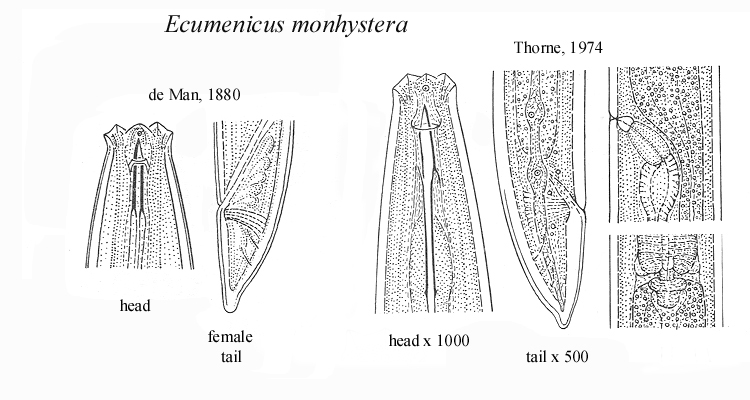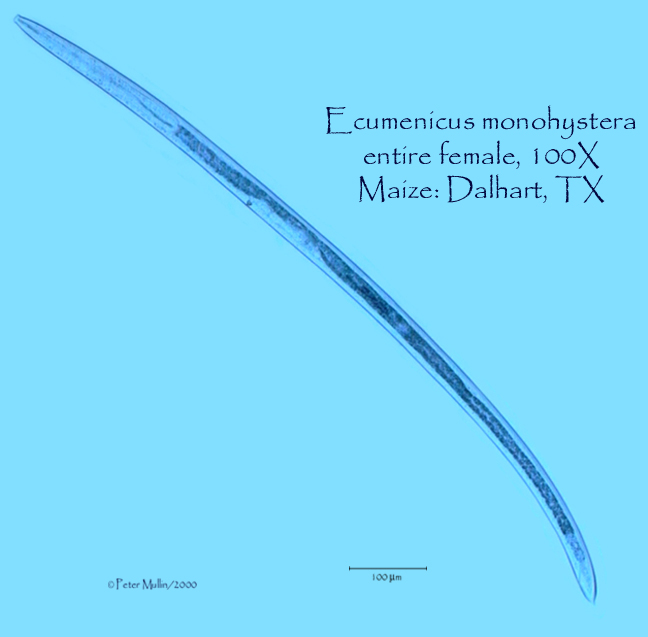Nematode
of the Week
Ecumenicus
monohystera
 
Ecumenicus monohystera (de Man, 1880) Thorne, 1974
Syns. Dorylaimus monohystera de Man, 1880
Dorylaimus gibbero-aculeatus Kreis, 1930
Eudorylaimus monohystera (de Man, 1880) Andrassy, 1959
Indokochinema ekramullahi Jana & Baqri, 1983
Photo
Gallery
Ecumenicus monohystera is distinctive among members of
the Qudsianematinae (Dorylaimoidea: Qudsianematidae) for its single, posteriorly-directed
ovary. The only other genus in this subfamily expressing this character
is Indokochinema Darekar & Khan, 1979, one species of which
has been synonymized with E. monohystera. Indokochinema
itself may be synonymous with Ecumenicus (Jairajpuri and Ahmad,
1992), although the status of its one remaining species, I. conicauda
Darekar & Khan, 1979 remains to be determined. Specimens of E.
monohystera have been recovered from our survey site at Konza
Prairie, as well as from a bison
wallow at Konza. This nematode has also been found at 9 Mile
Prairie, near Lincoln, NE, as well as from agricultural fields in Texas.
E. monohystera is considered an omnivore, but like other Qudsianematinae
may very well be predaceous.
Peter
Mullin
Descriptions:
Thorne, 1974:
"Ecumenicus new
genus
Dorylaimidae: Nemas
1.0-1.4 mm long. Lateral field a single line of cells
and from each a minute tubule
leads to a pore at the surface. Dorsal gland
nucleus located almost adjacent
to its pore. Vulva at 33-37%, a transverse
slit with slightly sclerotized
labia and vagina extending posteriorad. Ovary
single, reflexed.
No anterior uterine branch. Tail bluntly digitate. Only a
single species known.
Type species: Ecumenicus monohystera (de Man, 1880) n. comb.
Synonyms: Dorylaimus monohystera, de Man, 1880
Eudorylaimus monohystera (de Man, 1880) Andrassy 1959
Dorylaimus
gibbero-aculeatus Kreis, 1930
L = 1.1 mm; a = 30; b = 4.5; c = 28; V
= 35
Lips distinct, the region set off by slight expansion.
Spear 11u long with
aperture 1/3 its length. Guiding ring refractive, about 1/3 head
width.
Esophagus a slender, nonmuscular tube in anterior 3/5, then about half
neck
width in posterior 2/5. Dorsal esophageal gland nucleus only
slightly
behind its pore. Pairs of submedian gland pores arranged similar
to those
of Eudorylaimus. A slight isthmus joins esophagus and
cardia. Cardia
discoid, then bluntly conoid. Small hyaline structures in cardiac
region.
Cells of intestine with scattered dark granules. Gonad as described
above.
Prerectum length 2-3 times width body. Tail as illustrated.
Eggs 2-3 times
as long as body width.
Ecumenicus monohystera is world-wide in distribution. Morphological
characters and measurements of specimens from different continents
are
most remarkable for their similarity."
Thorne and Swanger, 1957:
"Kreis reports a male, the only one ever collected: Length 1.0 mm;
width 3.8;
esophagus 25.0; and tail 3.8 per cent of total length; supplements
eight; tail
form and supplement arrangement very similar to that of Dorylaimus
microdorus.
The principal diagnostic characters of Dorylaimus gibbero-aculeatus
Kreis,
1930, are: A single circlet of labial papillae and the appearance of
the
vestibule and spear. Since all dorylaims possess two circlets
of labial
papillae and the appearance of the vestibule and spear apparently is
due to
a fixation artifact, the species is synonymized with D. monohystera."
Measurements of Konza Prairie specimens (n = 3):
| L |
a |
b |
c |
c' |
V |
Odontostyle |
Aperture |
Lip region |
| 1123 |
31.78 |
4.77 |
34.47 |
1.54 |
34.67 |
11 |
3.33 |
11.33 |
-
References:
-
Jairajpuri, M.S. and Ahmad, W.
1992. Dorylaimida: Free-living, Predaceous, and Plant-parasitic
Nematodes. E.J. Brill, Leiden. 458 pp.
-
Thorne, G. 1974. Nematodes of the Northern
Great Plains. Part II Dorylaimoidea in part (Nemata: Adenophorea).
South Dakota State University Technical Bulletin 41. 120 pp.
-
Thorne, G. and Swanger, H.H.
1957. A monograph of the Nematode Genera Dorylaimus Dujardin,
Aporcelaimus
n.g., Dorylaimoides n.g. and Pungentus n.g. Martinus
Nijhoff, The Hague, Netherlands. 225 pp.
|

